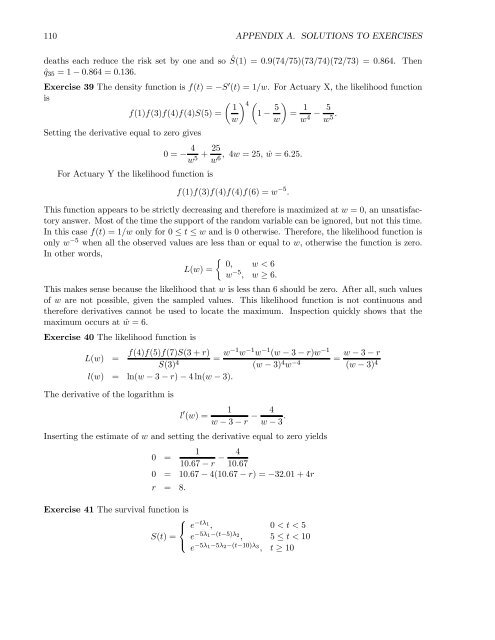Estimation, Evaluation, and Selection of Actuarial Models
Estimation, Evaluation, and Selection of Actuarial Models
Estimation, Evaluation, and Selection of Actuarial Models
You also want an ePaper? Increase the reach of your titles
YUMPU automatically turns print PDFs into web optimized ePapers that Google loves.
110 APPENDIX A. SOLUTIONS TO EXERCISES<br />
deaths each reduce the risk set by one <strong>and</strong> so Ŝ(1) = 0.9(74/75)(73/74)(72/73) = 0.864. Then<br />
ˆq 35 =1− 0.864 = 0.136.<br />
Exercise 39 The density function is f(t) =−S 0 (t) =1/w. For Actuary X, the likelihood function<br />
is<br />
µ 1 4 µ<br />
f(1)f(3)f(4)f(4)S(5) = 1 − 5 <br />
= 1 w w w 4 − 5 w 5 .<br />
Setting the derivative equal to zero gives<br />
0=− 4 w 5 + 25 , 4w =25, ŵ =6.25.<br />
w6 For Actuary Y the likelihood function is<br />
f(1)f(3)f(4)f(4)f(6) = w −5 .<br />
This function appears to be strictly decreasing <strong>and</strong> therefore is maximized at w =0, an unsatisfactory<br />
answer. Most <strong>of</strong> the time the support <strong>of</strong> the r<strong>and</strong>om variable can be ignored, but not this time.<br />
In this case f(t) =1/w only for 0 ≤ t ≤ w <strong>and</strong> is 0 otherwise. Therefore, the likelihood function is<br />
only w −5 when all the observed values are less than or equal to w, otherwise the function is zero.<br />
In other words,<br />
½ 0, w < 6<br />
L(w) =<br />
w −5 , w ≥ 6.<br />
This makes sense because the likelihood that w is less than 6 should be zero. After all, such values<br />
<strong>of</strong> w are not possible, given the sampled values. This likelihood function is not continuous <strong>and</strong><br />
therefore derivatives cannot be used to locate the maximum. Inspection quickly shows that the<br />
maximum occurs at ŵ =6.<br />
Exercise 40 The likelihood function is<br />
L(w) =<br />
f(4)f(5)f(7)S(3 + r)<br />
S(3) 4 = w−1 w −1 w −1 (w − 3 − r)w −1<br />
(w − 3) 4 w −4 = w − 3 − r<br />
(w − 3) 4<br />
l(w) = ln(w − 3 − r) − 4ln(w − 3).<br />
The derivative <strong>of</strong> the logarithm is<br />
l 0 1<br />
(w) =<br />
w − 3 − r − 4<br />
w − 3 .<br />
Inserting the estimate <strong>of</strong> w <strong>and</strong> setting the derivative equal to zero yields<br />
0 =<br />
1<br />
10.67 − r − 4<br />
10.67<br />
0 = 10.67 − 4(10.67 − r) =−32.01 + 4r<br />
r = 8.<br />
Exercise 41 The survival function is<br />
⎧<br />
⎨ e −tλ 1<br />
,<br />
0
















